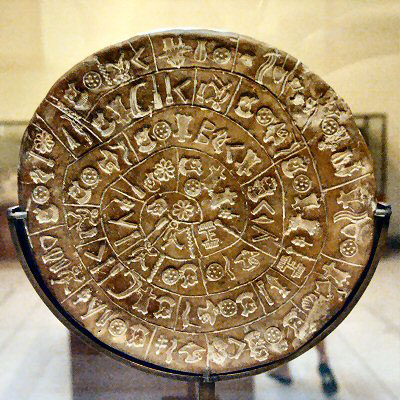|
THE ENIGMA OF THE ‘PHAISTOS DISC’
It was on July 3, 1908 – exactly one hundred years ago – that an Italian archaeologist, excavating a Minoan site in southern  Crete called Phaestos, discovered in its ruins a clay disc bearing unknown symbols on both sides. Crete called Phaestos, discovered in its ruins a clay disc bearing unknown symbols on both sides.
The discovered object, a disc about 4.5 inches in diameter, has since come to be known as The Phaestos Disc; and for a century now has baffled all who tried to unravel its mystery: For there has been found no other object like it, no writing as its pictographs, no inkling regarding its language, or to what people it owes its existence. Yet there it is, for anyone interested to see, in Crete’s Iraklion Museum.
On one of my Earth Chronicles Expeditions tours, we went to Crete. A must see are the ruins of Knossos, the Minoan capital excavated by Sir Arthur Evans. We also went to the Museum to see the disc; and I told the guide: I want to visit Phaestos. No one goes there, she said; there is nothing there to see, she said – just ruins of some buildings. But I insisted: There’s something on the disc that intrigues me!
We intended to spend a quick one hour there; we ended up being there the whole day. It was a day of thrilling discoveries.  These were not just “some buildings”. We found merchants’ stalls, each identified with stone blocks inscribed with product symbols. We found evidence that the place was a copper processing facility, that it had a connecting slideway to the seashore below. This was a commercial and industrial center, next to sea lanes! These were not just “some buildings”. We found merchants’ stalls, each identified with stone blocks inscribed with product symbols. We found evidence that the place was a copper processing facility, that it had a connecting slideway to the seashore below. This was a commercial and industrial center, next to sea lanes!
What was it about the disc that made me want to come here? Our guide asked. Contrary to accepted wisdom that the disc’s pictographs are unique, I said, I have seen some of them before: Ships and men with a plumed headdress – in Egypt and in Mayan Chichen Itza in Mexico!
You can read more about my guess that they were the mysterious “People of the Sea” and might have reached the Mediterranean from the Americas, in my book The Earth Chronicles Expeditions. It’s an appropriate centennial anniversary thriller. |

Social Links: